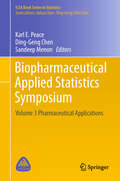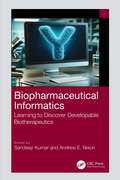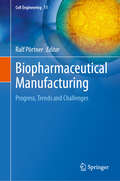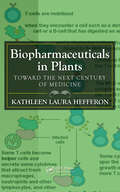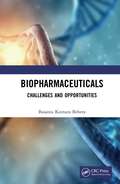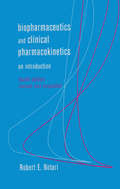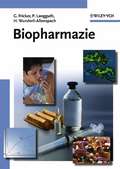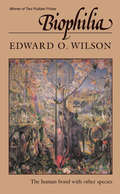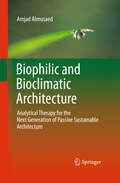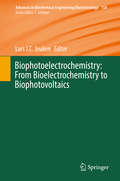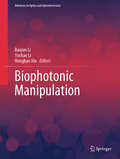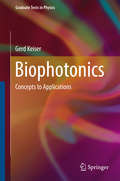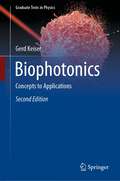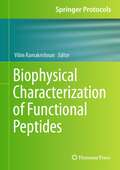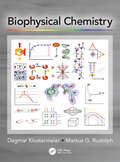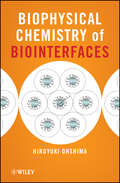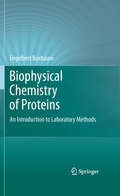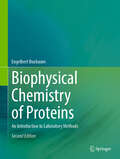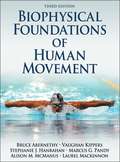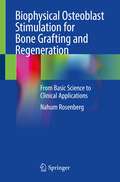- Table View
- List View
Biopharmaceutical Applied Statistics Symposium: Volume 3 Pharmaceutical Applications (ICSA Book Series in Statistics)
by Ding-Geng Chen Karl E. Peace Sandeep MenonThis BASS book Series publishes selected high-quality papers reflecting recent advances in the design and biostatistical analysis of biopharmaceutical experiments – particularly biopharmaceutical clinical trials. The papers were selected from invited presentations at the Biopharmaceutical Applied Statistics Symposium (BASS), which was founded by the first Editor in 1994 and has since become the premier international conference in biopharmaceutical statistics. The primary aims of the BASS are: 1) to raise funding to support graduate students in biostatistics programs, and 2) to provide an opportunity for professionals engaged in pharmaceutical drug research and development to share insights into solving the problems they encounter.The BASS book series is initially divided into three volumes addressing: 1) Design of Clinical Trials; 2) Biostatistical Analysis of Clinical Trials; and 3) Pharmaceutical Applications. This book is the third of the 3-volume book series. The topics covered include: Targeted Learning of Optimal Individualized Treatment Rules under Cost Constraints, Uses of Mixture Normal Distribution in Genomics and Otherwise, Personalized Medicine – Design Considerations, Adaptive Biomarker Subpopulation and Tumor Type Selection in Phase III Oncology Trials, High Dimensional Data in Genomics; Synergy or Additivity - The Importance of Defining the Primary Endpoint, Full Bayesian Adaptive Dose Finding Using Toxicity Probability Interval (TPI), Alpha-recycling for the Analyses of Primary and Secondary Endpoints of Clinical Trials, Expanded Interpretations of Results of Carcinogenicity Studies of Pharmaceuticals, Randomized Clinical Trials for Orphan Drug Development, Mediation Modeling in Randomized Trials with Non-normal Outcome Variables, Statistical Considerations in Using Images in Clinical Trials, Interesting Applications over 30 Years of Consulting, Uncovering Fraud, Misconduct and Other Data Quality Issues in Clinical Trials, Development and Evaluation of High Dimensional Prognostic Models, and Design and Analysis of Biosimilar Studies.
Biopharmaceutical Informatics: Learning to Discover Developable Biotherapeutics
by Sandeep Kumar Andrew E. NixonDespite the phenomenal clinical success of antibody-based biopharmaceuticals in recent years, discovery and development of these novel biomedicines remains a costly, time-consuming, and risky endeavor with low probability of success. To bring better biomedicines to patients faster, we have come up with a strategic vision of Biopharmaceutical Informatics which calls for syncretic use of computation and experiment at all stages of biologic drug discovery and pre-clinical development cycles to improve probability of successful clinical outcomes. Biopharmaceutical Informatics also encourages industry and academic scientists supporting various aspects of biotherapeutic drug discovery and development cycles to learn from our collective experiences of successes and, more importantly, failures. The insights gained from such learnings shall help us improve the rate of successful translation of drug discoveries into drug products available to clinicians and patients, reduce costs, and increase the speed of biologic drug discovery and development. Hopefully, the efficiencies gained from implementing such insights shall make novel biomedicines more affordable for patients.This unique volume describes ways to invent and commercialize biomedicines more efficiently: Calls for digital transformation of biopharmaceutical industry by appropriately collecting, curating, and making available discovery and pre-clinical development project data using FAIR principles Describes applications of artificial intelligence and machine learning (AIML) in discovery of antibodies in silico (DAbI) starting with antigen design, constructing inherently developable antibody libraries, finding hits, identifying lead candidates, and optimizing them Details applications of AIML, physics-based computational design methods, and other bioinformatics tools in fields such as developability assessments, formulation and excipient design, analytical and bioprocess development, and pharmacology Presents pharmacokinetics/pharmacodynamics (PK/PD) and Quantitative Systems Pharmacology (QSP) models for biopharmaceuticals Describes uses of AIML in bispecific and multi-specific formats Dr Sandeep Kumar has also edited a collection of articles dedicated to this topic which can be found in the Taylor and Francis journal mAbs.
Biopharmaceutical Manufacturing: Progress, Trends and Challenges (Cell Engineering #11)
by Ralf PörtnerThis volume “Cell Engineerring 11 - Biopharmaceutical Manufacturing: Progress, Trends and Challenges” is a source of the latest innovative research and technical development in biomanufacturing systems. It is organised into 2 parts: 1) Manufacturing of recombinant therapeutic proteins (e.g. therapeutic antibodies, biosimilars/biogenerics) and 2) Manufacturing aspects of cell and gene therapy. Each with selected chapters on the following topics for both up- and downstream, such as: Advanced process strategies, especially continuous manufacturing, Advanced culture techniques, especially single-use systems, Process transfer, scale-up/scale-down models, Processing advances/Manufacturing productivity/efficiency, Model-assisted process understanding and development/Digital Twins, Process controls and analytics, Quality control, Quality by design, Facility design and full-scale commercial systems, manufacturing technology innovation.The book comprises contributions of experts from academia and industry active in the field of cell culture development for the production of recombinant proteins, cell therapy and gene therapy, with consideration of Digital Twin´s and facility design. The knowledge and expertise of the authors cover disciplines like cell biology, engineering, biotechnology and biomedical sciences. Inevitably, some omissions will occur in the test, but the authors have sought to avoid duplications by extensive cross-referencing to chapters in other volumes of this series and elsewhere. We hope the volume provides a useful compendium of techniques for scientists in industrial and research laboratories active in this field.
Biopharmaceuticals in Plants: Toward the Next Century of Medicine
by Kathleen Laura HefferonTransgenic plants present enormous potential to become one of the most cost-effective and safe systems for large-scale production of proteins for industrial, pharmaceutical, veterinary, and agricultural uses. Over the past decade, much progress has been made with respect to the development of vaccines, antibodies, and other therapeutic proteins. Bi
Biopharmaceuticals: Challenges and Opportunities
by Basanta Kumara BeheraBiopharmaceuticals: Challenges and Opportunities This book highlights how the traditional microbial process technology has been upgraded for the production of biologic drugs how manufacturing processes have evolved to meet the global market demand with quality products under the guidelines of internally recognized regulatory bodies. It also carries information on how, armed with a deeper understanding of life-threatening diseases, biopharmaceutical companies and the life sciences industry have developed formal and informal partnerships with researchers in institutes, universities, and other R&D organizations to fulfil timely, quality production with perfect safety and security. One of the most interesting aspects of this book is the conceptual development of personalized medicine (or precision medicine) to provide the right treatment to the right patient, at the right dose at an earlier stage of development, for genetic diseases. Besides this, it also highlights the most challenging aspects of modern biopharmaceutical science, focusing on the hot topics such as design and development of biologic drugs; the use of diversified groups of host cells belonging to animals, plants, microbes, insects, and mammals; stem cell therapy and gene therapy; supply chain management of biopharmaceuticals; and the future scope of biopharmaceutical industry development. This book is the latest resource for a wide circle of scientists, students, and researchers involved in understanding and implementing the knowledge of biopharmaceuticals to develop life-saving biologic drugs and to bring awareness to the development of personalized treatment that can potentially offer patients a faster diagnosis, fewer side effects, and better outcomes. Features: Explains how the traditional cell culture methodology has been changed to a fully continuous or partially continuous process Explains how to design and fabricate living organs of body by 3D bioprinting technology Focuses on how a biopharmaceutical company deals with various problems of regulatory bodies and develops innovative biologic drugs Narrates in detail the updated information on stem cell therapy and gene therapy Explains the development strategies and clinical significance of biosimilars and biobetters Highlights the supply chain management of biopharmaceuticals
Biopharmaceutics and Clinical Pharmacokinetics: An Introduction, Fourth Edition
by Robert E. NotariFor a decade and a half, Biopharmaceutics and Clinical Pharmacokinetics has been used in theclassrooms around the world as an introductory textbook on biophannaceutics and phannacokinetics. Now, the new Fourth Edition, Revised and Expanded further enhances the preceding editions'proven features, introducing significant advances in clinical pharmacokinetics, pharmacokineticdesign of drugs and dosage forms, and model-independent analyses. Still usable without prior knowledge of calculus or kinetics, this successfully implemented workbookmaintains a carefully graduated "building block" presentation, incorporating sample problemsand exercises throughout for a thorough understanding of the material.Biopharmaceutics and Clinical Pharmacokinetics features a growth-oriented format that systematicallydevelops and interrelates all subject matter .. . introduces basic theory and fields of application... emphasizes model-independent pharmacokinetic analyses ... presents biopharmaceutical aspectsof product design and evaluation .. . offers a unique approach to teaching dosage regimen design andindividualization . .. and considers structural modification of drug molecules for problems associatedwith pharmacokinetics. As a comprehensive coverage of the basic principles and the recent achievements in the field, noother textbook does as much for students of pharmacy, pharmacology, medicinal chemistry, andmedicine, or for scientists who desire a simple but thorough introduction to theory and application.
Biopharmazie
by Peter Langguth Heidi Wunderli-Allenspach Gert FrickerDurch die j ngste nderung der Approbationsordnung f r Apotheker hat die Bedeutung der Biopharmazie in Forschung und Lehre weiter zugenommen. In diesem vollst ndig neu konzipierten Lehr- und Handbuch behandeln renommierte Autoren s mtliche Themen der Biopharmazie entsprechend den neuen Anforderungen. Aktuell und bersichtlich, richtet sich das Grundlagenwerk an Pharmazeuten in Wissenschaft und Industrie, aber auch an Studenten, die besonders von den integrierten bungsteilen profitieren. Die Hauptkapitel zu den Grundlagen der Physiologie und Pharmakokinetik werden erg nzt durch Abschnitte zu Anwendungen der Biopharmazie in der Arzneimittelentwicklung und in der Klinik. Zu topaktuellen Themen wie Prodrugs und Drug Targeting referiert der Band den Stand der Forschung. F r Praktiker h lt er au erdem ein Kapitel zu Computerprogrammen in der Biopharmazie bereit. Auch Studenten hat das Buch eine Menge zu bieten: Zahlreiche bungsaufgaben sowie Verst ndnisfragen mit den dazugeh rigen Antworten erlauben eine effektive Lernkontrolle und damit eine optimale Pr fungsvorbereitung. Der Band folgt der Terminologie der Europ ischen Pharmakop e 2001. Das ausf hrliche Glossar enth lt mehr als 100 Begriffe. Au erdem werden ber 130 pharmakokinetische Abk rzungen und Symbole erkl rt, so dass das Buch auch als Nachschlagewerk genutzt werden kann. Das Autorenteam hat sich einiges vorgenommen: Ihr Buch soll das Referenzwerk der Biopharmazie werden, f r Studenten und Dozenten der Pharmazie, Pharmazeuten und Pharmakologen ebenso wie f r Praktiker in der Pharmaindustrie.
Biophilia
by Edward O. WilsonBiophilia is Edward O. Wilson's most personal book, an evocation of his own response to nature and an eloquent statement of the conservation ethic. Wilson argues that our natural affinity for life—biophilia—is the very essence of our humanity and binds us to all other living species.
Biophilic and Bioclimatic Architecture: Analytical Therapy for the Next Generation of Passive Sustainable Architecture
by Amjad AlmusaedBiophilic and Bioclimatic Architecture is a guide to innovative architectural design for architects, engineers and other specialists who are working with biophilic and bioclimatic architectural concepts. Biophilic and Bioclimatic Architecture has three parts: * Part I focuses on the relationship between architecture and human needs and the creation process, demonstrating the meaning of architectural value in architectural hypothesis. * Part II opens the way towards a new understanding of biophilic architecture as a response to the negative actions of humans and the negative effects of using natural resources. * Part III shows the benefits of combining the effects of the climate with the notion of human comfort in bioclimatic architecture.
Biophotoelectrochemistry: From Bioelectrochemistry to Biophotovoltaics (Advances in Biochemical Engineering/Biotechnology #158)
by Lars J.C. JeukenThis book review series presents current trends in modern biotechnology. The aim is to cover all aspects of this interdisciplinary technology where knowledge, methods and expertise are required from chemistry, biochemistry, microbiology, genetics, chemical engineering and computer science.Volumes are organized topically and provide a comprehensive discussion of developments in the respective field over the past 3-5 years. The series also discusses new discoveries and applications. Special volumes are dedicated to selected topics which focus on new biotechnological products and new processes for their synthesis and purification.In general, special volumes are edited by well-known guest editors. The series editor and publisher will however always be pleased to receive suggestions and supplementary information. Manuscripts are accepted in English.
Biophotonic Manipulation (Advances in Optics and Optoelectronics)
by Baojun Li Yuchao Li Hongbao XinThis book offers a thorough overview of the rapidly expanding field of biophotonic manipulation, delving into topics such as the fundamentals of optical forces, technologies of optical manipulation, and their applications in the biomedical field. The recent recognition of Arthur Ashkin with the Nobel Prize for his groundbreaking work on optical tweezers has sparked a renewed interest and importance in the realm of optical manipulation. In response to this, the authors present a timely and comprehensive book that focuses on the basics and uses of various optical manipulation technologies, catering to a readership with a strong interest in this advancing field. This book not only enhances readers&’ current knowledge base but also serves as a valuable resource for researchers, scientists, and enthusiasts looking to gain a deeper understanding of the transformative power of optical manipulation.
Biophotonics: Concepts to Applications (Graduate Texts in Physics)
by Gerd KeiserThis book introduces senior-level and postgraduate students to the principles and applications of biophotonics. It also serves as a valuable reference resource or as a short-course textbook for practicing physicians, clinicians, biomedical researchers, healthcare professionals, and biomedical engineers and technicians dealing with the design, development, and application of photonics components and instrumentation to biophotonics issues. The topics include the fundamentals of optics and photonics, the optical properties of biological tissues, light-tissue interactions, microscopy for visualizing tissue components, spectroscopy for optically analyzing the properties of tissue, and optical biomedical imaging. It also describes tools and techniques such as laser and LED optical sources, photodetectors, optical fibers, bioluminescent probes for labeling cells, optical-based biosensors, surface plasmon resonance, and lab-on-a-chip technologies. Among the applications are optical coherence tomography (OCT), optical imaging modalities, photodynamic therapy (PDT), photobiostimulation or low-level light therapy (LLLT), diverse microscopic and spectroscopic techniques, tissue characterization, laser tissue ablation, optical trapping, and optogenetics. Worked examples further explain the material and how it can be applied to practical designs, and the homework problems help test readers' understanding of the text.
Biophotonics: Concepts to Applications (Graduate Texts in Physics)
by Gerd KeiserThis book introduces senior-level and postgraduate students to the principles and applications of biophotonics. It also serves as a valuable reference resource or as a short-course textbook for practicing physicians, clinicians, biomedical researchers, healthcare professionals, and biomedical engineers and technicians dealing with the design, development, and application of photonics components and instrumentation to biophotonics issues. The topics include the fundamentals of optics and photonics, the optical properties of biological tissues, light-tissue interactions, microscopy for visualizing tissue components, spectroscopy for optically analyzing the properties of tissue, and optical biomedical imaging. It also describes tools and techniques such as laser and LED optical sources, photodetectors, optical fibers, bioluminescent probes for labeling cells, optical-based biosensors, surface plasmon resonance, and lab-on-a-chip technologies. Among the applications are optical coherence tomography (OCT), optical imaging modalities, photodynamic therapy (PDT), photobiostimulation or low-level light therapy (LLLT), diverse microscopic and spectroscopic techniques, tissue characterization, laser tissue ablation, optical trapping, and optogenetics. Worked examples further explain the material and how it can be applied to practical designs, and the homework problems help test readers’ understanding of the text.This second edition provides updates as follows:1) Updated references in each chapter with recent review papers, tutorials, and generic research results.2) New sections in Chap. 3 addressing tapered fibers for sensors, biocompatibility issues of optical fibers, and concepts of implantable fibers.3) Updates in Chaps. 4 and 5 on optical sources and photodetectors discussing fiber-based sources, silicon photomultipliers, and high-speed cameras for biosensing.4): Sections on improvements in microscopy, imaging, spectroscopy, and sensing in Chapters 7–10. 5) New biophotonic application techniques in Chap. 11 will include optogenetic advances, smart phones for imaging, wearable biophotonic sensors, and robotic surgery and light therapy.
Biophysical Applications of Satellite Remote Sensing (Springer Remote Sensing/Photogrammetry)
by Jonathan M. HanesA variety of biophysical applications (e. g. leaf area index and gross primary productivity) have been derived from measurements of the Earth system obtained remotely by NASA's MODIS sensors and other satellite platforms. In Biophysical Applications of Satellite Remote Sensing, the authors describe major applications of satellite remote sensing for studying Earth's biophysical phenomena. The focus of the book lies on the broad palette of specific applications (metrics) of biophysical activity derived using satellite remote sensing. With in-depth discussions of satellite-derived biophysical metrics that focus specifically on theory, methodology, validation, major findings, and directions of future research, this book provides an excellent resource for remote sensing specialists, ecologists, geographers, biologists, climatologists, and environmental scientists.
Biophysical Characterization of Functional Peptides (Springer Protocols Handbooks)
by Vibin RamakrishnanThis protocol book presents reproducible and step-by-step procedures for the peptide synthesis, their characterization and applications. The volume includes an introductory section on in silico modelling of new peptide molecules, Molecular Dynamics Simulations, Docking, Electrostatic fingerprinting of peptides, and other modelling tools for peptide designing and optimization. Further, it covers protocols for the solid phase peptide synthesis, chromatographic and mass spectrometric characterization of peptides. Importantly, it covers methods for biophysical characterizations of peptides for their potential applications as drug delivery vehicles, peptide nano-assembly, bionanocatalysis, protein aggregation diseases, and peptide-based anti-bacterial.
Biophysical Chemistry
by Dagmar Klostermeier Markus G. RudolphBiophysical Chemistry explores the concepts of physical chemistry and molecular structure that underlie biochemical processes. Ideally suited for undergradate students and scientists with backgrounds in physics, chemistry or biology, it is also equally accessible to students and scientists in related fields as the book concisely describes the fundamental aspects of biophysical chemistry, and puts them into a biochemical context. The book is organized in four parts, covering thermodynamics, kinetics, molecular structure and stability, and biophysical methods. Cross-references within and between these parts emphasize common themes and highlight recurrent principles. End of chapter problems illustrate the main points explored and their relevance for biochemistry, enabling students to apply their knowledge and to transfer it to laboratory projects. Features: Connects principles of physical chemistry to biochemistry Emphasizes the role of organic reactions as tools for modification and manipulation of biomolecules Includes a comprehensive section on the theory of modern biophysical methods and their applications
Biophysical Chemistry
by Dagmar Klostermeier Markus G. RudolphBiophysical Chemistry explores the concepts of physical chemistry and molecular structure that underlie biochemical processes. Ideally suited for undergraduate students and scientists with backgrounds in physics, chemistry, or biology, it is also equally accessible to students and scientists in related fields as the book concisely describes the fundamental aspects of biophysical chemistry and puts them into a biochemical context.This second edition has been fully updated throughout with novel techniques, with a new chapter on advances in cryo-electron microscopy and exciting new content throughout on big data techniques, structural bioinformatics, systems biology and interaction networks, and artificial intelligence and machine learning.The book is organized in four parts, covering thermodynamics, kinetics, molecular structure and stability, and biophysical methods. Cross-references within and between these parts emphasize common themes and highlight recurrent principles. End of chapter problems illustrate the main points explored and their relevance for biochemistry, enabling students to apply their knowledge and to transfer it to laboratory projects.Key Features: Connects principles of physical chemistry to biochemistry Emphasizes the role of organic reactions as tools for modification and manipulation of biomolecules Includes a comprehensive section on the theory of modern biophysical methods and their applications
Biophysical Chemistry of Biointerfaces
by Hiroyuki OhshimaThe first book on the innovative study of biointerfaces using biophysical chemistry The biophysical phenomena that occur on biointerfaces, or biological surfaces, hold a prominent place in the study of biology and medicine, and are crucial for research relating to implants, biosensors, drug delivery, proteomics, and many other important areas. Biophysical Chemistry of Biointerfaces takes the unique approach of studying biological systems in terms of the principles and methods of physics and chemistry, drawing its knowledge and experimental techniques from a wide variety of disciplines to offer new tools to better understand the intricate interactions of biointerfaces. Biophysical Chemistry of Biointerfaces: Provides a detailed description of the thermodynamics and electrostatics of soft particles Fully describes the biophysical chemistry of soft interfaces and surfaces (polymer-coated interfaces and surfaces) as a model for biointerfaces Delivers many approximate analytic formulas which can be used to describe various interfacial phenomena and analyze experimental data Offers detailed descriptions of cutting-edge topics such as the biophysical and interfacial chemistries of lipid membranes and gel surfaces, which serves as good model for biointerfaces in microbiology, hematology, and biotechnology Biophysical Chemistry of Biointerfaces pairs sound methodology with fresh insight on an emerging science to serve as an information-rich reference for professional chemists as well as a source of inspiration for graduate and postdoctoral students looking to distinguish themselves in this challenging field.
Biophysical Chemistry of Proteins: An Introduction to Laboratory Methods
by Engelbert BuxbaumThe book is structured in nine sections, each containing several chapters. The volume starts with an overview of analytical techniques and progresses through purification of proteins; protein modification and inactivation; protein size, shape, and structure; enzyme kinetics; protein-ligand interactions; industrial enzymology; and laboratory quality control. The book is targeted at all scientists interested in protein research.
Biophysical Chemistry of Proteins: An Introduction to Laboratory Methods
by Engelbert BuxbaumThis textbook, designed for all scientists interested in protein research, provides a thorough overview of laboratory methods for the biophysical chemistry of proteins. This new edition, completely restructured and expanded for ease of learning, includes sections on analytical techniques, working with proteins, protein size and shape, protein structure, enzyme kinetics, industry enzymology, and a new section on special statistics.
Biophysical Ecology (Dover Books on Biology)
by David M. GatesThis classic and highly influential text presents a uniquely comprehensive view of the field of biophysical ecology. In its analytical interpretation of the ecological responses of plants and animals to their environments, it draws upon studies of energy exchange, gas exchange, and chemical kinetics.The first four chapters offer a preliminary treatment of the applications of biophysical ecology, discussing energy and energy budgets and their applications to plants and animals, and defining radiation laws and units. Succeeding chapters concern the physical environment, covering the topics of radiation, convection, conduction, and evaporation. The spectral properties of radiation and matter are reviewed, along with the geometrical, instantaneous, daily, and annual amounts of both shortwave and longwave radiation. The book concludes with more elaborate analytical methods for the study of photosynthesis in plants and energy budgets in animals, in addition to animal and plant temperature responses.This text will prove of value to students and environmental researchers from a variety of fields, particularly ecology, agronomy, forestry, botany, and zoology.
Biophysical Economy: Theory, Challenges, and Sustainability (Applied Ecology and Environmental Management)
by Steven M. BartellThis book explores the concept of transforming the current macroeconomic system from one based on continuous growth that doesn’t recognize the fundamental importance of Earth's natural support structures, to a system consistent with the basic views of biophysical economics that acknowledges that all real wealth ultimately derives from planetary resources, both renewable and non-renewable. It describes how data and information collected by various institutions, government agencies, and the private sector can be integrated with existing management structures to transform the “continuous growth” economy into an economy that functions within understandable boundaries on a finite planet. Features Stimulates discussions of the feasibility of a biophysical economy. Discusses the historical developments of biophysical economics. Offers a practical approach to building a biophysical economy. Explores the human experience of living in a biophysical economy. Emphasizes the fragility of life in the Universe as we know it. This book is an excellent resource for academics and students studying sustainable development, as well as for professionals working in the private sector and public institutions with an interest in economic planning for a sustainable future.
Biophysical Foundations of Human Movement (3rd Edition)
by Bruce Abernethy Vaughan Kippers Stephanie Hanrahan Marcus Pandy Ali Mcmanus Laurel Mackinnon"Biophysical Foundations of Human Movement, Third Edition," introduces readers to key concepts concerning the anatomical, mechanical, physiological, neural, and psychological bases of human movement. The text provides undergraduate students with a broad foundation for more detailed study of the subdisciplines of human movement and for cross-disciplinary studies. Readers will learn the multi-dimensional changes in movement and movement potential that occur throughout the life span as well as those changes that occur as adaptations to training, practice, and other lifestyle factors. This third edition includes the latest research and improved presentation to address areas of growth and change in the fields of human movement. The following are important updates to this edition: - A new chapter on historical origins of human movement science provides students with an appreciation of the development of the field as well as its future directions. - Content regarding exercise physiology has been reorganized to provide more discrete coverage of key concepts in nutrition. - A new concluding section focuses on applications in the areas of prevention and management of chronic disease, prevention and management of injury, and performance enhancement in sport and the workplace, as well as the benefits of sport and exercise science to work, sport, and everyday living. - Ancillary materials support instructors in teaching across disciplines as they assist students in understanding the breadth of content in this comprehensive text. Using a modular approach to teaching sport and exercise science, "Biophysical Foundations of Human Movement, Third Edition," offers students a structured understanding of how the subdisciplines work independently and in tandem. Following a general introduction to the field of human movement studies, readers are introduced to basic concepts, life-span changes, and adaptations arising in response to training in each of the five major biophysical subdisciplines of human movement. Each subdiscipline is given a brief introduction, including the definition and historical development of the subdiscipline, the typical issues and problems it addresses, the levels of analysis it uses, and relevant professional training and organizations. Multi-disciplinary and cross-disciplinary approaches to human movement are also discussed along with contemporary applications. By studying the integration of knowledge from a number of the biophysical subdisciplines, students will be better prepared for advanced study and careers reliant on the integration of knowledge from various disciplines and perspectives. The third edition offers tools for retaining the material, including learning objectives and summaries in each chapter, a glossary, and lists of web-based resources. Throughout the text, special "In Focus" features highlight key organizations, individuals, and studies from around the world that have contributed to the current understanding of human movement. These features help readers appreciate the evolution of the field so that they may better understand its direction. Students interested in further study will find specialized texts for each of the subdisciplines listed in the Further Reading and References section of each chapter along with updated lists of websites. The third edition of "Biophysical Foundations of Human Movement" offers a comprehensive introduction for students, scientists, and practitioners involved in the many professions grounded in or related to human movement, kinesiology, and sport and exercise science. By considering the effect of adaptations in each of the biophysical subdisciplines of human movement, "Biophysical Foundations of Human Movement" also illustrates the important role physical activity plays in the maintenance of health throughout the life span.
Biophysical Methods for Biotherapeutics
by Tapan K. DasWith a focus on practical applications of biophysical techniques, this book links fundamental biophysics to the process of biopharmaceutical development.* Helps formulation and analytical scientists in pharma and biotech better understand and use biophysical methods * Chapters organized according to the sequential nature of the drug development process * Helps formulation, analytical, and bioanalytical scientists in pharma and biotech better understand and usestrengths and limitations of biophysical methods * Explains how to use biophysical methods, the information obtained, and what needs to be presented in a regulatory filing, assess impact on quality and immunogenicity * With a focus on practical applications of biophysical techniques, this book links fundamental biophysics to the process of biopharmaceutical development.
Biophysical Osteoblast Stimulation for Bone Grafting and Regeneration: From Basic Science to Clinical Applications
by Nahum RosenbergThis book integrates the current basic and clinical knowledge in the area of biophysical stimulation of osteoblast for in vitro and in vivo live bone generation. This innovative methodology and its applications are presented and discussed in several clinical conditions: treatment of fracture nonunion, spine stabilization, bone replacement after tumor resections, stabilization of failed joint endoprostheses in revision surgery and in treatment of bone loss (osteoporosis and osteopenia). The author analyses different types of biophysical stimulation of osteoblasts for bone regeneration, e.g. mechanical (static and alternating, including distraction osteogenesis), electromagnetic (pulsed, alternating, static), light (at different spectrum range, including laser), acoustic (including ultrasound), RF etc. Moreover, he summarizes and discusses the most significant findings for in vitro bone generation and its resulting clinical use as autologous bone graft without surgical morbidity. Reflecting the author’s extensive experience this book is an excellent source of knowledge and a valuable aid to clinical practice for all orthopedic surgeons, fellows, and researchers wanting to gain insights into this promising field.
